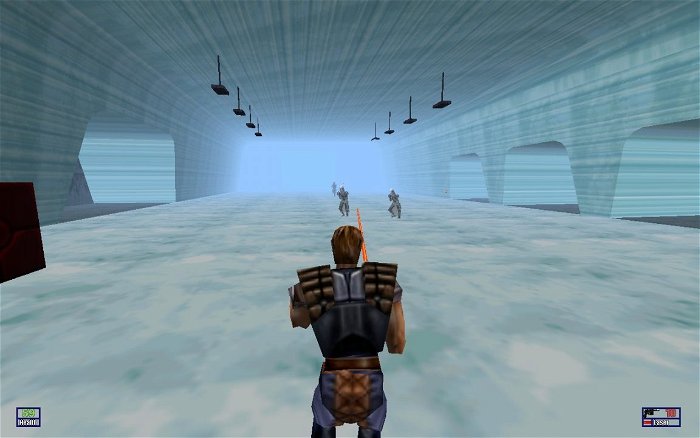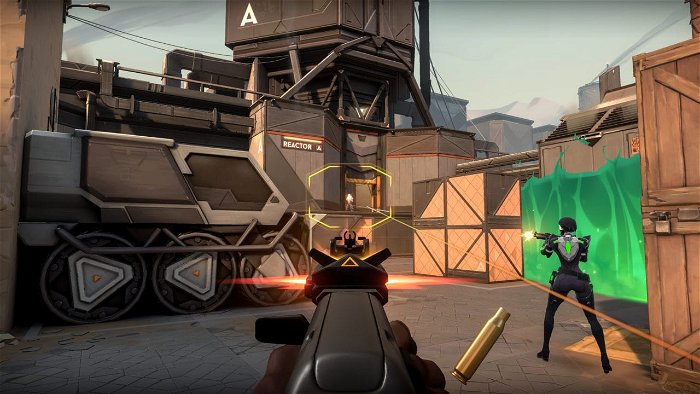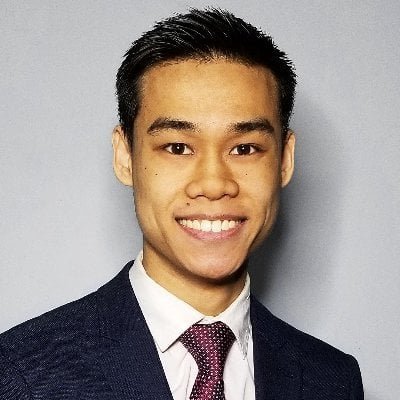28-year-old Rich Horgan remembers saving an Outer Rim from The Galactic Empire over a dust-free Nintendo 64 with his younger brother, Terry over 20 years ago.
In hours of game time, realities of the world around them were put on pause. Large hurdles in life were traded for small victories as the siblings watched each other beat through the latest Star Wars game to grace the late 90’s.
During that time, both were discovering their new-found passions for video games in separate ways.
Terry developed a lifelong condition with Duchenne Muscular Dystrophy (DMD); a rare disease Horgan defined as a loss of muscle which impairs movement. As the progressive DMD prevented Terry’s physical activities, he continued playing on his strengths with the push of a button in titles such as Star Wars: Galaxies and ARMA. Terry’s reflexes grew through generations of consoles, while his own characters became an extension for exploring vast game worlds.
Decades later, Rich Horgan continued to remember the life-changing impact video games granted for his younger brother. Keeping in touch with Terry through countless online adventures, he left for Harvard’s Business School and eventually founded Cure Rare Disease – a non-profit medical research company treating others with conditions such as DMD – in hopes of ultimately succeeding.
CGMagazine remotely sat with Cure Rare Disease President and founder Rich Horgan as he personally discussed Gaming to Cure Rare Disease; a charity initiative pushed into action as the worldwide COVID-19 pandemic set in-person efforts back. Through combining fundraising platform Tiltify and its integration in Twitch, Horgan said streamers of every level have an opportunity to change their research.
CGMagazine: How old was Terry When he started playing video games?
Rich Horgan: Oh man, I think one of the first video games we ever played was Star Wars: Shadows of the Empire (N64, released 1996). I love that game. He must have been probably five or six years old. He was super young. He went on to build his own computer a couple years later and started playing Star Wars Galaxies, which he and I were huge fans of. He moved into Call of Duty and Arma for a while and now Arma‘s really what he focuses on. So for Terry, it’s probably been 15 to 16 years being able to take advantage of an alternate reality where if you’re able to play with individuals and game with an individual, regardless of whatever he’s able to do or not be able to do in real life.

CGMagazine: So it was relatively early when you both fell in love with video games?
Rich Horgan: Yeah, well it’s not a funny story, but it’s somewhat of a heartwarming story. Because like most kids, you know, you go outside and you play baseball or basketball or something as kids. From an early age, Terry wasn’t able to do that quite as well. Instead of going out playing basketball, we tended to play more video games. And so it became a sort of a common bond between Terry and I to play video games and then when I went off to college, we would still play you know, Star Wars Galaxies together even though we were physically in different locations. That sort of thing to me was very uplifting and gave Terry an out where he may not have had one beforehand.
CGMagazine: Personally for you (in recent memory), at what point did you realize video games were a way to progress with Cure Rare Disease’s research?
Rich Horgan: We’re all personally motivated here. Everybody that’s involved with Cure Rare Disease is somehow touched by a rare disease, either themselves or through their family members, like in my case. So we want to let gamers know that we’re here, that we’re advancing a really good cause to save lives, many of which unfortunately wouldn’t have been saved otherwise by traditional drug development because the disease is so rare. We want to work together. You know, we want to show the power that streamers can have over literally curing a disease that has claimed the lives of every person prior to now. I think that’s a motivating mission. I think that’s something that that can get people excited about working together.
I think oftentimes when you say “Okay I want to help make the world a better place,” there’s many ways you could do it. But sort of seeing that direct translation from what I do, to expecting a positive outcome is oftentimes difficult to get. What I noticed about gaming and gamers as a way to create positive changes is that again, these individuals want to do well by the world and want to make it a better place. Here we have an opportunity where we can, for lack of a better term: get two birds with one stone in the sense that gamers game and as a result of fundraising, they’re able to literally save the lives of individuals.

CGMagazine: With COVID-19 keeping the world indoors, how have the discussions changed for Cure Rare Disease around video games?
Rich Horgan: What we’ve what we’ve decided to do is try to accelerate our march into the streaming space by conversations like these. By getting our name out there, we intend to participate in some of the larger conferences that are conducive to getting in front of gamers and sharing the message. So, as much as we’re able to do sort of working from home, we really want to drive that forward. And so I’ve got a person working to reach out to gamers via Twitter.
So, all hands are working on this, and this is a major initiative of Cure Rare Disease. Yes it’s young and yes it’s early, but I have a great degree of confidence that we’re going to be able to raise a significant amount of capital – all of which will go towards helping these children suffering from these terrible diseases. So, the short answer is it’s accelerated. We’re moving on as quickly as possible.
CGMagazine: Based on what you’ve seen so far, how big is the gaming community in Boston?
Rich Horgan: You know, it’s more active than I would have expected. I think with presences like Helix, with a lot of universities (leagues), with individuals to fit into that, you know, 20 to 35 age range that seems to be a primary demographic. It is more active than I would have initially expected and it’s certainly growing at least here in Boston and we think in conversations, we’re seeing similar things in like San Diego, for instance, I know there was a conference here more than a month ago, here in Boston, PAX East, I believe. It’s certainly a growing field, especially in the coastal areas.
We have a contact at Activision, helping us informally to connect with gamers, such as those in active in the fundraising space. So, you know, we’re starting to see it’s a very nascent field, but I think it’s ripe for an opportunity to partner with gamers and really show them how they can make a difference.

CGMagazine: I’ve read that Tiltify is also the main platform. What made this the choice, compared to other existing formats such as Twitch, YouTube and Mixer?
Rich Horgan: I would say that the integration of Tiltify as a fundraising platform into Twitch as another layer made it really attractive, right? You can connect our Tiltify. Our program is connected to Twitch so if a gamer wants to stream, they just connect the two and you can use it as a fundraising tool, whereas some of these other programs don’t seem to have that interconnectedness that’s really critical because I think as a gamer, it needs to be a theme with a process as possible to be able to do what the gamer intended to do which to game and then add that layer of having the ability to fund raise on top of it. So the two: Twitch and Tiltify work together really nicely in that sense and it was a really attractive platform. We’re on there and active, so just trying to create the infrastructure that would allow gamers to help support the cause.
And also the fact that, I think a lot of charities have higher overhead rates, meaning that you want to be sure that your dollar is really going to advance the cause. Not just sort of being wasted on unnecessary overhead. So these are good options that Tiltify has and of course, I’d like to see the platform expand out more and partnerships continue to grow with Tiltify where maybe they highlight a charity a month or something like that.
30 to 40 years ago, games were very different, right? Like the 8-bit sort Mario games for instance. Well, we’re are the next generation of medical innovation, whereas streaming is the next generation for video games. So that was another sort of feature that that made it an attractive thing to look into.

CGMagazine: What are some of the goals established for raising research funds through video games?
Rich Horgan: Our goals are really to get word out there. Since we’re early in this endeavor and initiative, our goals are to raise awareness of gamers actively looking to support charities that say “Hey, we’re here. Our followers love gaming, they’re heavily involved in it.” The work we’re doing and the funds we raised through gaming will go directly to our followers to help cure their rare diseases.
Right now, we’re focused almost entirely on Duchenne Muscular Dystrophy to prove the concept can work. From there, we’ll expand to other diseases like we just talked about. And for the time being, we want to let people know that their impact and awareness of our mission directly translate into storing more individuals of rare disease.
CGMagazine: Of course, going into the early stages of the initiative, what are some of the challenges in connecting video games with medical research?
Rich Horgan: I think some of the challenges in connecting video games and medical research is that it’s awareness right, I think you know, we personally are a young organization. So, it takes time to get the word out and raise awareness that they may exist and seeing what we’re doing has the power to save lives. Speaking sort of more broadly, rather than just focus on Cure Rare Disease, I think some of the challenges are that gamers may not know the power that they have, in what they do every day to affect really positive outcomes.
It’s sort of connecting the dots to say “Look, you’re doing this anyway, you have anywhere from a few followers, to a few tens of thousands of followers. Simply by connecting with a charitable cause, you can help accelerate that mission by doing something you would have done anyway.”

CGMagazine: Are there any specific financial number of goals laid out to how much money you want to raise?
Rich Horgan: we’re thinking through it and sort of getting getting our feet wet with the field, but I you know, I’d love to see, you know, of course, now we have this virus we’re dealing with. But I also think the virus is a great opportunity because people are inside to really look at “how can I help the world even though I can’t go outside?” Streaming as a fundraiser for often is an amazing answer because you know a lot of our in-person fundraisers have been cancelled.
Our electronic fundraisers are becoming much more relevant. But I’d love to see you know, to raise 50 or $100,000 this year through streaming and I think it’s possible. We’ve got a lot of gamers who are very passionate, we’re looking for a good cause. And, you know, I invite them to learn more about what we’re doing. I guarantee once an individual hears the message, they get it, and you know, and they have such an ability to help advance it. It’s incredible.
To find out how you, an organization or eSports League can contribute, see Cure Rare Disease‘s info here.




